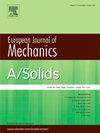了解指数分级涂层-基底结构中的粘合滑动纳米接触力学原理
IF 4.4
2区 工程技术
Q1 MECHANICS
引用次数: 0
摘要
本研究的目的是研究滑动刚性圆柱体与指数分级涂层-基底结构之间的摩擦粘附纳米接触特性。粘附力使用 Maugis-Dugdale 粘附理论建模,而 Steigmann-Ogden 表面力学理论则描述了分级涂层的表面效应。在接触区域内,法向和切向牵引力遵循扩展的阿蒙顿摩擦定律。纳米接触问题的控制方程和边界条件被重新表述为弗雷德霍姆积分方程,并使用高斯-雅各比四元数和自行设计的迭代算法对其进行数值求解。根据现有的文献结果进行验证,证明了所提出的求解方法和数值算法的准确性和可靠性。通过广泛的参数研究,考察了各种参数的影响,包括表面材料特性、摩擦系数、Tabor 参数、指数分级涂层的不均匀指数以及外部载荷。结果表明,滑动摩擦对纳米粘合接触有显著影响,会影响纳米接触边界、接触牵引力分布和粘合区域边界。此外,表面效应也起着关键作用,导致纳米接触长度和最大压力变小,但粘合区域变大。此外,研究还强调了滑动摩擦、表面效应和粘附之间的相互作用,强调了在分析涉及分级材料的滑动纳米接触问题时考虑这些因素的重要性。最终,这项研究为解决此类复杂的纳米接触问题提供了一个全面的解决方案框架,为材料科学与工程领域提供了宝贵的见解。本文章由计算机程序翻译,如有差异,请以英文原文为准。
Understanding adhesive sliding nanocontact mechanics in an exponentially graded coating–substrate structure
The objective of this study is to investigate the frictionally adhesive nanocontact characteristics between a sliding rigid cylinder and an exponentially graded coating–substrate structure. Adhesive forces are modeled using the Maugis–Dugdale adhesive theory, while the Steigmann–Ogden surface mechanical theory describes the surface effects of the graded coating. Within the contact region, normal and tangential tractions adhere to the extended Amontons’ friction law. The governing equations and boundary conditions of the nanocontact problem are reformulated into Fredholm integral equations, which are solved numerically using Gauss–Jacobi quadratures and a self-designed iterative algorithm. Validation against existing literature results demonstrates the accuracy and reliability of the proposed solution method and numerical algorithm. Extensive parametric studies are conducted to investigate the effects of various parameters, including surface material properties, coefficient of friction, Tabor’s parameter, inhomogeneity index of the exponentially graded coating, and external loads. Results reveal that sliding friction significantly influences adhesive nanocontact, affecting nanocontact boundaries, contact traction distribution, and adhesive region boundaries. Additionally, surface effects play a crucial role, leading to smaller nanocontact length and maximum pressure but larger adhesive zone. Furthermore, the interplay between sliding friction, surface effects, and adhesion is underscored, emphasizing the importance of considering these factors in the analysis of sliding nanocontact problems involving graded materials. Ultimately, this work provides a comprehensive solution framework for addressing such complex nanocontact scenarios, offering insights valuable to the field of materials science and engineering.
求助全文
通过发布文献求助,成功后即可免费获取论文全文。
去求助
来源期刊
CiteScore
7.00
自引率
7.30%
发文量
275
审稿时长
48 days
期刊介绍:
The European Journal of Mechanics endash; A/Solids continues to publish articles in English in all areas of Solid Mechanics from the physical and mathematical basis to materials engineering, technological applications and methods of modern computational mechanics, both pure and applied research.

 求助内容:
求助内容: 应助结果提醒方式:
应助结果提醒方式:


